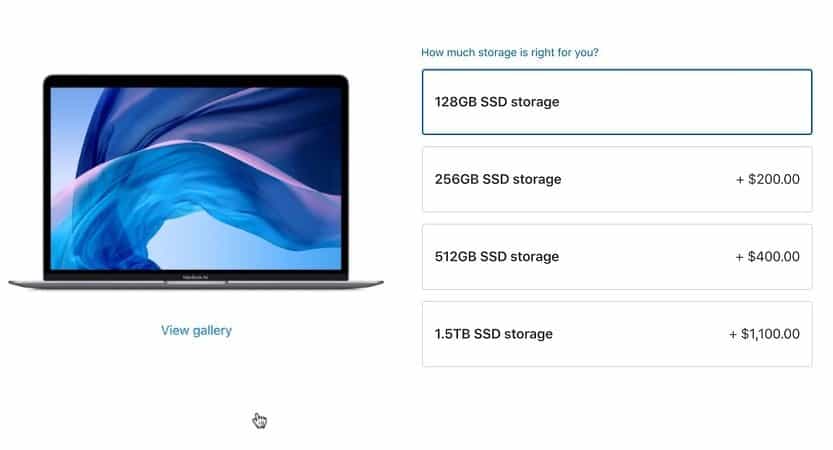
- #MACBOOK SYSTEM STORAGE 305 GB DRIVERS#
- #MACBOOK SYSTEM STORAGE 305 GB MANUAL#
- #MACBOOK SYSTEM STORAGE 305 GB FREE#
It's not clear whether you've actually purged it yet or have only identified it as purgeable - but that's where I'd focus for now.Īs another option - I know you've already used Daisy Disk and Disk Inventory X, and neither one has given you the information you need. I suspect that that "purgeable" data covers almost all of that extra space. I've got an MBP that's been incrementally upgraded through like four versions of MacOS. Don't know why it would have assigned them to the System folder, but I've seen weirder things before.ġ68gb is still crazy-large, though. Random errors can lead the file system allocating chunks of storage that aren't associated with any file. Yes, Disk Utility would've been my first recommendation. I'll keep an eye on the size of "System", but for now I would call this solved. "System" is still using ~200GB of storage, however it appears that for whatever reason it may be including ~165GB of iTunes data (iTunes claims to be using zero kb in the storage management window). Running "sudo tmutil disablelocal" from the terminal disables the local backup feature and has cleared all but 7GB of the "Purgeable" data. MobileBackups folder, which housed some 600GB of "Purgeable" local backup data. Scanning as admin in DaisyDisk found the.

"System" has now been reduced to 168GB, but I still have 352GB of purgeable data, which still does not fall in line with the data I have stored locally or on iCloud drive.Įdit: /u/aadharsh_2 and /u/halninefounsand had it right. I have now repaired the drive by running first-aid from recovery mode. I'm running Sierra 10.12.3 on a late 2013 rMBP with a 1TB SSD.Įdit: Running first-aid from disk utility determined the drive was corrupted but could be repaired. Screenshots Edit: Updated with Daisy Disk and Disk Inventory X screenshot'sĪs far as I can with the figure mentioned above I'm personally only using ~220GB, which leaves the remainder largely unaccounted for. I have removed all videos (expect for a couple sitting in dropbox for a client, ~760MB total), and can't see anything else that would be using the space. I also have 20GB worth of applications installed. My user folder is only 200GB including 165GB of music, and ~20GB of photo's. Is anyone able to tell me what "System" includes? I've just noticed in system information that "System" is taking up 400GB of space on my drive.
#MACBOOK SYSTEM STORAGE 305 GB FREE#
The PCle SSDs are more expensive, especially the ones designed for Macbook Pro.In an attempt to free up some space for a large Final Cut project I have been removing a number of other smaller projects etc. After all, you’re going to choose an SSD flash drive only because you want to increase the capacity of your Macbook Pro. There are transfer speed limits for flash drives, such as the 2.5’’ one, and the more the MB/s the more expensive it is.Ĭapacity is one of the most important factors to consider before you choose an SSD flash drive. The read and write speeds are very important factors as they will determine the tangible speed of your Macbook Pro. The connection type and form factor of the SSD flash drive determine the overall speed of the device. In older Macbook pros (before late 2012), the installation of 2.5 ‘’ SATA III is very easy you just have to change the hard drive for the SSD and your work is done. The OWC Aura SSD flash drives need formatting too before installation.
#MACBOOK SYSTEM STORAGE 305 GB DRIVERS#
You must also look for the compatibility of the drivers before installing the SSD drive.
#MACBOOK SYSTEM STORAGE 305 GB MANUAL#
If your Macbook Pro is equipped with an m.2 SSD type, follow the instructions of the manual provided with the SSD you’ve bought.

It is always a good idea to follow the instructions of the device. To access the internal components of your machine, you’ll need special screwdrivers that could remove the plate.

The installation of the SSD flash drive depends on the version of the Macbook Pro you own. Installation:Ĭhanging SSD or installing it is a daunting task and thus it is important that you do it only when you’re an expert and have some prior knowledge. Thus, it is imperative that you do some research and look for the requirements of the Macbook Pro according to its version. The Macbook Pros prior to 2014 are compatible with SATA III interface 2.4 inch SSDs. These devices are compatible with m.2 SSD that runs through PCle slot and not SATA. Macbook Pros (Retinas) starting from the version 2013 to the early 2016 are compatible with advanced and compact memory types. All of the versions of Macbook Pro are compatible with particular interfaces. Before you choose the best compatible SSD for your Macbook Pro, here are some factors you should consider: Macbook Pro version and SSD type:īefore choosing the type of SSD, you must first consider the version of Macbook Pro you have.


 0 kommentar(er)
0 kommentar(er)
